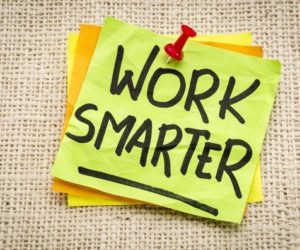Growth mindset is the belief in one’s capacity to acquire information and grow, a concept that is becoming more and more popular in the world when it comes to education and training, as it changes and improves the way in which people learn.
When speaking about growth mindset, we cannot ignore it’s opposite: the fixed mindset.
The two terms were coined by Carol Dweck and popularized in the book Mindset: The New Psychology of Success. As a renowned psychologist and professor at Stanford, she discovered that people’s mindsets play a crucial role in the process of learning.
Fixed vs Growth Mindset
A person with a fixed mindset believes that skills and intelligence are set, that some people are naturally good at doing something. Also, the concept of fixed mindset applies to a person who doesn’t believe they can achieve a goal or who does not see the value in learning more than what they already know.
By opposition, the person with a growth mindset understands that he or she is in control of their own abilities. These types of individuals know that skills and intelligence are grown and developed in time, as people who are good at something have worked and built on achieving that ability.

Growth mindset is the very essence of learning and the person who possesses this mindset, realizes that there’s always room for improvement.
How to Evaluate Your Mindset?
The best way to observe if you have a growth or a fixed mindset is to analyze your behavior and especially the choices you are making. If you are one who believes that we, as human beings, have to learn and to improve constantly, you will act accordingly, always finding ways to study and better yourself.
Generally speaking, when we say we have a certain mindset or we value something, we need to look at the way we choose.
As you’re considering the choices that you make every day, think about this:
- How often are you choosing learning over personal comfort?
- How often are you choosing comfort over learning?
- How often would you like to choose learning over personal comfort?
Ask Better Questions
If you find the example of comfort vs learning debatable, maybe something more controversial, such as health, will help put things into a perspective.
When asked directly, every person tends to say that their health is important to them. But instead of posing the classic question “Do you value your health?”, you can ask better questions that assist in determining the type of mindset:
- How often do you choose your health more than you choose your comfort?
- How often do you choose your health more than you choose relaxing?
- Do you value your health more than eating a very tasty meal? etc.
With these examples in mind, I feel you will be better equipped for the evaluation of your behaviors, which will then catapult you into starting your growth mindset journey.
My Model
As with any good thing, one has to follow some guidelines that lead to success and great achievements.
So how do I self-promote a growth mindset? With my own model, based on 7 pillars:
1. Mindset evaluation through behaviors
I’ve already covered this very important pillar in the chapter above, so if you’ve managed to establish the type of mindset that you have and the one you want to develop – hopefully a growth mindset – you are ready to go further.
2. Growth as an investment
Everybody knows that learning is a venture, but making it count, that’s the challenge.
I treat my growth as you would treat a regular investment. By definition, an investment is an action you are taking now for a later benefit. And, as with all investments a good prioritization on what’s next is important.
Personally, I am looking at both the skills needed for my current role, and the abilities required for my next – wished – role. I evaluate what is needed in order to succeed, and self-evaluate where I need to grow, then start my learning journey from that point on.
3. The 70:20:10 learning model
This model is considered to bring tremendous value, as it maximizes the effectiveness of learning. Created in the ‘80s by three researches working with a nonprofit educational institution in North Carolina, US, it is still being used today by organizations around the world, in their development programs.
I cannot stress enough that the key to growth must be as in the original presented model: 70% experience, 20% interaction and 10% formal training. The latter two act as accelerators to the experience possessed by the individual, and it cannot be the other way around – learning and interactions as the main pillar and experience on a second position.
4. Accelerated learning through interaction (feedback)
Feedback is a great way of achieving accelerated learning through interaction. Unlike the individual with the fixed mindset who does not see the value or purpose of feedback, the person who has developed a growth mindset welcomes it and is more receptive to feedback, because the focus is on getting better.
I am constantly seeking feedback and trying to get it from every individual and team that I work with, as there is no doubt in my mind that information can help growth.
5. Getting out of your comfort zone
When confronted with getting out of the comfort zone, the brain doesn’t want anything to change. Stepping outside the comfort zone creates ‘good stress’ that helps ramp up one’s focus, creativity, progress and drive – valuable elements in the learning process.
Naturally, you’re going to achieve more, as your increased concentration and focus will help you develop new skills. In turn, these new abilities will change the way you see yourself, acting as an encouraging factor that will actually make you step further out of your comfort zone. How about that for a twist?
6. Inspect and adapt
Such as the slogan of some Scrum teams, inspect and adapt represent the pillars that offer help in reflecting and identifying the problems accumulated in a person’s ‘backlog’. In essence, it’s based on the same Scrum principles of using the results, failures and processes encountered, for development purposes.
This goes back to the growth mindset idea that accepting one’s mistakes is actually a step forward, into the learning process. And adaptation takes creativity in responding to the findings of introspection. It keeps us from stagnating, as we avoid addressing today’s problem with the solution to yesterday’s issue.
Feel free to visit my Trello board for 2019, for more inspiration.
I inspect my growth progress every week, by reviewing what I’ve done and taking the opportunity to change something for the next week. Then, I do a more in-depth inspection every month, as I mostly take a look on the items that pushed my growth further vs. the ones that kept me tied to things I already know.
I also do a value check every 6 months, by getting extended feedback from people that know me and can evaluate how much I am living my life according to my pursued values. Finally, I carry out a one-year review with the purpose of observing the changes achieved, compared to last year.
7. Giving back
Giving back is the final, logical outcome, following the development of the growth mindset.
Enriching and giving back to the community is an important Pentalog value. Through knowledge sharing, we ensure that passion for great things and valuable information is being passed down to others who need it.
Pentalog is continuing the commitment made towards the community through PentaBAR tech meet-ups, PentaLIVE interventions, internships and other learning opportunities, such as Scrum Master & PO Camp, as well as by maintain different internal communities & programs that Penta Guys/ Penta Girls can be part of.

If you’ve missed my PentaBAR presentation on Growth Mindset – The Key to a Successful Tech Career, you can watch it here.
Final Thoughts
This is my model, and I know that it might not be fit for you. Therefore, I highly encourage you to extend it and/ or use it as a template for your own growth mindset model.
Just so you can have an idea of my journey, I started developing my model around 5 years ago; it is perpetually transforming and evolving and it will continue to be so, in true growth spirit. I am constantly adapting it because I believe adaptation is the key to success.
Hopefully, I was able to whet your appetite in discovering the growth mindset. With it, the sky will truly be your limit, as you will be able to learn, grow and achieve more over time, instead of being stuck into a fixed mindset.
Your Growth Mindset Cheat Sheet
Here are some references, to help you continue your growth mindset journey:
- BooksIt’s always good to start at the source, so I recommend reading Carol Dweck’s book, Mindset: The New Psychology of Success, first.Then, if you’re still into books – like me – you can continue with Growth Mindset Lessons – Every child is a learner, by Katherine Muncaster and Shirley Clarke, Angela Duckwoth’s Grit: The Power of Passion and Perseverance, and Hyper-Learning: How to Adapt to the Speed of Change written by Edward D. Hess.
- VideosIf you’re more of a visual learner, you need to watch the following videos:Developing a growth mindset with Carol Dweck
Angela Duckwoth at Ted Talk – Grit: The power of passion and perseverance
- Checklists
One of the best checklists I know can be found in the third chapter of the book Hyper-Learning, written by Edward D. Hess, which I mentioned above.
Have a great, fulfilling growth!










